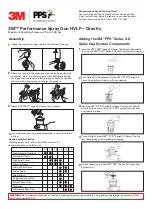
19
1. Changing the nozzle orifice
To ensure a good texture you should select a nozzle orifice that is at least double the diameter of the largest plaster
grain.
To do this, loosen the two knurled nuts (3). When the trigger is actuated the nozzle disc (2) can be easily rotated to the
desired position (4 - 13 mm diameter holes).
Make sure the sealing ring (5) is applied cleanly behind the nozzle disc. The nozzle is centred over the hole by releasing
the trigger. The upper knurled nut can then be retightened, followed by the lower nut.
2. Adjusting the air flow
The amount of air required by the plaster gun is approximately 220 l / min. A working pressure of 2 - 3 bar is generally
sufficient for all spray applications.
The amount of air can be easily adjusted via the high-pressure valve on the plaster gun. The more air you select, the
finer the spray pattern will be. If you work with too much air, it can cause the individual grains of sand to be separated
from the binding agent and rebound from the wall. This results in loss of material and contamination.
3. Consistency of the mixed material
An important prerequisite for reliable operation is the use of evenly mixed material that is free of any coarse impurities.
It is necessary to keep the plaster thick enough so that it just slides down into the hopper gun. The plaster droplets
then remain on the processed surface and form a beautiful texture.
A common misconception, however, is to thin the plaster if you want a finer texture. In this case, it is far better to use
a smaller nozzle or to select a higher volume of air.
4. Adjusting the supply of material
A thumb screw is located at the side of the handle, which can be used to adjust and lock the amount of material that
is required. As a rule of thumb, please note that the distance between the air nozzle (24) and the material nozzle (6)
must be slightly larger than the selected nozzle hole. You can check this distance by unscrewing the nozzle disc (2).
You will quickly determine the correct volume of material and settings for your hopper gun.
5. Cleaning the device
Please wash thoroughly with water, blow through the nozzle orifice and clean the exterior of the gun on a regular basis.
Caring for your device and keeping it clean will ensure reliable operation.










































